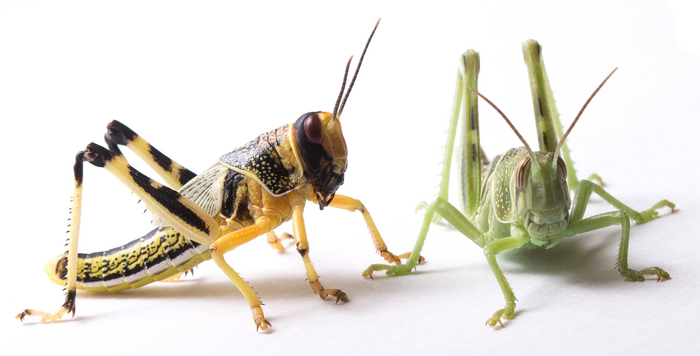June 27, 2022–The first high-quality genome of the desert locust—those voracious feeders of plague and devastation infamy and the most destructive migratory insect in the world—has been produced by U.S. Department of Agriculture Agricultural Research Service scientists.

Credit: Photo by Brandon Woo.
June 27, 2022–The first high-quality genome of the desert locust—those voracious feeders of plague and devastation infamy and the most destructive migratory insect in the world—has been produced by U.S. Department of Agriculture Agricultural Research Service scientists.
The genome of the desert locust (Schistocerca gregaria) is enormous at just under 9 billion base pairs, nearly three times the size of the human genome.
“We were concerned that, faced with this huge and very likely complex desert locust genome, it was going to be an extremely long and difficult job. However, we were able to go from sample collection to a final assembled genome in under 5 months,” said entomologist Scott M. Geib with the ARS Tropical Crop and Commodity Protection Research Unit in Hilo, Hawaii, and one of the team leaders. “The desert locust is one of the largest insect genomes ever completed and it was all done from a single locust.”
That one locust was provided by chemical ecologist Baldwyn Torto with the International Centre of Insect Physiology and Ecology (ICIPE) in Nairobi, Kenya. He and his team tracked down swarms of locusts, collecting specimens across Kenya until he had two parents that he was able to breed to produce an offspring of known pedigree.
The size of the desert locust’s chromosomes is remarkable; compare them to those of the model fruit fly Drosophila melanogaster, the first insect genome ever assembled. Many of the desert locust’s individual chromosomes are larger than the entire fruit fly genome.
“With the desert locust, we were dealing with a much larger genome in many fewer pieces—about 8.8 Gb in just 12 chromosomes. Next to the fruit fly, it’s like an 18-wheeler next to a compact car,” Geib said. “It was like sequencing a typical insect genome many, many times over. But with today’s advances in DNA sequencing technologies, we are now able to generate extremely accurate genomes of insects that previously would have been unapproachable.”
ARS has made the genome available to the international research community through the National Center for Biotechnology Information.
Desert locust plagues are cyclic and have been recorded since the times of the Pharaohs in ancient Egypt, as far back as 3200 B.C. In recent decades, there have been desert locust swarms in 1967-1969, 1986-1989 and most lately 2020-2022. They cause devastation in East Africa, the Middle East, and Southwest Asia, threatening food security in many countries.
Their damage can be massive. A small swarm can eat as much food in a day as would feed 35,000 people; a swarm of historic proportions covering the area of New York City eats in one day the same amount as the population of New York, Pennsylvania and New Jersey combined, according to the Food and Agriculture Organization of the United Nations.
Current desert locust control mostly depends on locating swarms and spraying them with broad-spectrum pesticides. Ultimately, this genomics work could decrease dependence on such pesticides.
“Having a high-quality genome is a big step toward finding targeted controls,” Geib said. “It will also give us valuable information about relatives of the desert locust that are major pests in the Americas such the Mormon cricket, another swarming species that can impact U.S. food security.”
This work is part of the Ag100Pest Initiative, an ARS program to develop high quality genomes for the top 100 arthropod pests in agriculture as a foundation for basic and applied research.
USDA Foreign Agricultural Service coordinated this research opportunity and provided funding from the U.S. Agency for International Development Africa Bureau through an interagency agreement.
The Agricultural Research Service is the U.S. Department of Agriculture’s chief scientific in-house research agency. Daily, ARS focuses on solutions to agricultural problems affecting America. Each dollar invested in agricultural research results in $17 of economic impact.
#
Five Desert Locust Facts
- The Desert Locust (Schistocerca gregaria) is a species of short-horned grasshopper that periodically changes its body shape, behavior, and reproduction rate in response to environmental conditions such as an abundance of rainfall and moisture.
- Plague is actually a technical term. Desert locust infestations are identified in a sequence of increasing severity based on magnitude and geographical scale of the swarm size: recession (calm), outbreak, upsurge, plague (maximum intensity and scope).
- Swarms can stay in the air for long periods of time. They regularly cross the Red Sea, about 300 km. They can also cover long distances: For example, Northwest Africa to the British Isles in 1954 and from West Africa to the Caribbean in about ten days in 1988. Swarms can travel up to 1,000 km in one week, about the distance between San Francisco and Seattle.
- A one-square-kilometer swarm can contain up to 80 million adult desert locusts.
- Each new generation in a swarm can be up to 20 times larger than the previous one.




